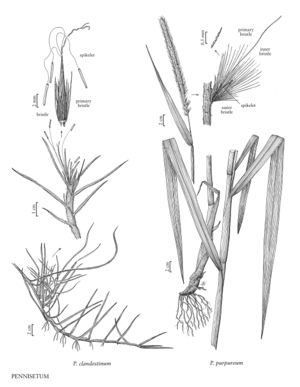Difference between revisions of "Pennisetum clandestinum"
FNA>Volume Importer |
FNA>Volume Importer |
||
| Line 17: | Line 17: | ||
-->{{Treatment/Body | -->{{Treatment/Body | ||
|distribution=Puerto Rico;Virgin Islands;Calif.;Pacific Islands (Hawaii) | |distribution=Puerto Rico;Virgin Islands;Calif.;Pacific Islands (Hawaii) | ||
| − | |discussion=<p>Pennisetum clandestinum is native to Africa. It now grows in many parts of the world, often as a forage or lawn grass. The U.S. Department of Agriculture considers it a noxious weed. In parts of the Flora region, it is well-established in lawns.</p> | + | |discussion=<p><i>Pennisetum clandestinum</i> is native to Africa. It now grows in many parts of the world, often as a forage or lawn grass. The U.S. Department of Agriculture considers it a noxious weed. In parts of the Flora region, it is well-established in lawns.</p> |
|tables= | |tables= | ||
|references= | |references= | ||
| Line 26: | Line 26: | ||
-->{{#Taxon: | -->{{#Taxon: | ||
name=Pennisetum clandestinum | name=Pennisetum clandestinum | ||
| − | |||
|authority=Hochst. ex Chiov. | |authority=Hochst. ex Chiov. | ||
|rank=species | |rank=species | ||
| Line 34: | Line 33: | ||
|family=Poaceae | |family=Poaceae | ||
|illustrator=Linda A. Vorobik | |illustrator=Linda A. Vorobik | ||
| + | |illustration copyright=Utah State University | ||
|distribution=Puerto Rico;Virgin Islands;Calif.;Pacific Islands (Hawaii) | |distribution=Puerto Rico;Virgin Islands;Calif.;Pacific Islands (Hawaii) | ||
|reference=None | |reference=None | ||
| Line 39: | Line 39: | ||
|publication year= | |publication year= | ||
|special status= | |special status= | ||
| − | |source xml=https:// | + | |source xml=https://jpend@bitbucket.org/aafc-mbb/fna-data-curation.git/src/f50eec43f223ca0e34566be0b046453a0960e173/coarse_grained_fna_xml/V25/V25_1352.xml |
|subfamily=Poaceae subfam. Panicoideae | |subfamily=Poaceae subfam. Panicoideae | ||
|tribe=Poaceae tribe Paniceae | |tribe=Poaceae tribe Paniceae | ||
Revision as of 20:33, 16 December 2019
Plants perennial; rhizomatous and stoloniferous. Culms 3-45 cm, decumbent, highly branching; nodes glabrous. Sheaths glabrous or pubescent; ligules 1.3-2.2 mm; blades 1-15 cm long, 1-6 mm wide, flat or folded, glabrous or pubescent. Panicles 2-2.7 cm, axillary, concealed in the sheaths; rachises flat, glabrous or scabrous. Fascicles 1-6; axes to 0.5 mm, with 1-2 spikelets; outer and inner bristles alike, 6-15, 0.5-10.9 mm; primary bristles 10-14 mm, usually not noticeably longer than the other bristles. Spikelets 10-22 mm, sessile or pedicellate, pedicels to 0.2 mm; lower glumes usually absent, sometimes to 0.5 mm, veinless; upper glumes 0-1.3(3.5) mm, veinless; lower florets sterile; lower lemmas 10-22 mm, 9-13-veined; lower paleas usually absent; upper lemmas 10-22 mm, 8-12-veined; upper paleas 2-7-veined; anthers 4.7-7 mm, long-exserted from the florets at anthesis. 2n = 36.
Distribution
Puerto Rico, Virgin Islands, Calif., Pacific Islands (Hawaii)
Discussion
Pennisetum clandestinum is native to Africa. It now grows in many parts of the world, often as a forage or lawn grass. The U.S. Department of Agriculture considers it a noxious weed. In parts of the Flora region, it is well-established in lawns.
Selected References
None.
